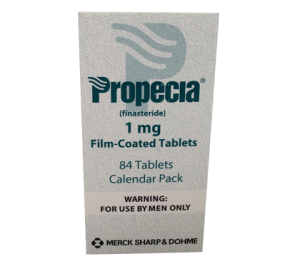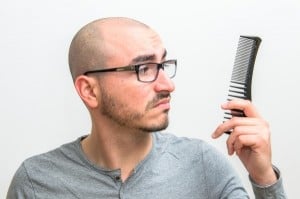Do I Have To See My GP To Get Finasteride?

What is male pattern hair loss?
Male pattern hair loss or androgenetic alopecia is a common condition in which men experience thinning of the hair on the scalp. In some cases, this results in a receding hairline or balding on the top of the head. These changes typically begin in men in their 20s.
The prognosis of androgenetic alopecia is not known. Some patients progress to the point where they lose almost all hair on the scalp. Others have a patterned or nonpatterned thinning but retain a considerable amount of hair on the scalp.
Is it normal to lose hair on a daily basis?
It is perfectly normal to lose on average about 100 strands of hair every day. However, some people tend to lose more hair than that which results in telogen effluvium. Telogen phase of the hair follicle growth cycle is the natural phase of scalp hair shedding. If hair follicles remain in telogen phase for a longer period of time than usual, it is likely that the person will start shedding hair leaving the scalp exposed. Such a change can be brought about by triggers such as trauma, childbirth, bereavement and even hormonal changes.
Click HERE to View Finasteride Prices > >
Signs of androgenetic alopecia include the following:
- Gradual onset;
- Increased hair shedding;
- Transition in the involved areas from large, thick, pigmented terminal hairs to thinner, shorter, indeterminate hairs and finally to short, wispy, non-pigmented vellus hairs;
- The result may be a total denudation area; this area varies from patient to patient and is usually most marked at the top.
What causes hair loss?
Doctors don’t know why certain hair follicles are programmed to have a shorter growth period than others. However, many factors may influence hair loss:
- Hormones;
- Genes, from both male and female parents, may influence a person’s predisposition to male or female pattern baldness;
- Stress, illness, and childbirth can cause temporary hair loss;
- Drugs, including chemotherapy drugs used in cancer treatment, blood thinners, beta-adrenergic blockers used to control blood pressure, and birth control pills, can cause temporary hair loss;
- Burns, injuries, and X-rays can cause temporary hair loss. In such cases, normal hair growth usually returns once the injury heals unless a scar is produced. Then, the hair will never regrow;
- Autoimmune disease may cause alopecia areata. In alopecia areata, the immune system revs up for unknown reasons and affects the hair follicles. In most people with alopecia areata, the hair grows back, although it may temporarily be very fine and possibly a lighter colour before normal colouration and thickness return;
- Cosmetic procedures, such as shampooing too often, perms, bleaching, and dyeing hair can contribute to overall hair thinning by making hair weak and brittle. Tight braiding, using rollers or hot curlers, and running hair combs through tight curls can also damage and break hair. However, these procedures don’t cause baldness. In most instances hair grows back normally if the source of the problem is removed;
- Medical conditions. Thyroid disease, lupus, diabetes, iron deficiency anaemia, eating disorders, and anaemia can cause hair loss. Most times, when the underlying condition is treated, the hair will return unless there is scarring as in some forms of lupus, lichen planus or follicular disorders;
- Diet. A low-protein diet or severely calorie-restricted diet can also cause temporary hair loss.
About Finasteride
Finasteride is the generic form of the brand-name drug Propecia. Propecia is a prescription only medication and so generally requires a visit to your GP or other healthcare professional.
Finasteride is the first 5alpha-reductase inhibitor that received clinical approval for the treatment of androgenetic alopecia (male pattern hair loss). Type II 5a-reductase is an intracellular enzyme that converts the androgen testosterone into 5a dihydrotestosterone (DHT).
According to the Food and Drug Administration (FDA) clinical trials, 83% of men who used Finasteride for two years either saw a complete stop of hair loss and an increase of hair growth or both.
How does it look?
Finasteride is a white crystalline powder. It is freely soluble in chloroform and in lower alcohol solvents but is practically insoluble in water. Finasteride tablets are film-coated tablets that contain 1 mg of Finasteride and other inactive ingredients such as lactose monohydrate and red ferric oxide.
Mechanism of action
The mechanism of action of Finasteride is based on its preferential inhibition of Type II 5a-reductase through the formation of a stable complex with the enzyme. Inhibition of Type II 5a-reductase blocks the peripheral conversion of testosterone to DHT, resulting in significant decreases in serum and tissue DHT concentrations, minimal to moderate increase in serum testosterone concentrations, and substantial increases in prostatic testosterone concentrations. As DHT appears to be the principal androgen responsible for stimulation of prostatic growth, a decrease in DHT concentrations will result in a decrease in prostatic volume (approximately 20-30% after 6-24 months of continued therapy). In men with androgenic alopecia, the mechanism of action has not been fully determined, but Finasteride has shown to decrease scalp DHT concentration to the levels found in a hairy scalp, reduce serum DHT, increase hair regrowth, and slow hair loss.
Pharmacokinetic properties
Absorption: the bioavailability of Finasteride is over 80%. Peak plasma concentrations are reached 2 hours after drug intake and absorption is complete after 6-8 hours;
Distribution: after a daily dose of 5 mg the lowest steady-state concentrations of Finasteride has been calculated to be 8-10ng/ml which remains stable over time;
Biotransformation: Finasteride is metabolized in the liver. Two metabolites with low 5a reductase inhibiting effects have been identified;
Elimination: the plasma half-life averages 6 hours. After administration of radioactively labelled Finasteride, approx. 39% of the given dose is excreted in the urine in the form of metabolites. Virtually no unchanged Finasteride is recovered in the urine. Approximately 57% of the total dose is excreted in the faeces.
The efficacy of Finasteride
The efficacy of Finasteride has been demonstrated in men (88% Caucasian) with mild to moderate androgenetic alopecia (male pattern hair loss) between 18 and 41 years of age. In order to prevent seborrheic dermatitis which might confound the assessment of hair growth in these studies, all men, whether treated with Finasteride or placebo, were instructed to use a specified, medicated, tar-based shampoo (Neutrogena T/Gel® Shampoo) during the first 2 years of the studies.
For 12 months, doctors studied over 1800 men aged 18 to 41 with mild to moderate amounts of ongoing hair loss. Of these men, approximately 1200 with hair loss at the top of the head participated in additional extension studies, resulting in a total study time of up to five years. In general, men who took Finasteride maintained or increased the number of visible scalp hairs and noticed an improvement in their hair in the first year. Improvement, compared to the start of the study, was maintained through the remaining years of treatment. Hair counts in men who did not take Finasteride continued to decrease. In one study, patients were questioned on the growth of body hair. Finasteride did not appear to affect hair in places other than the scalp.

Dosage and administration
The recommended dosage of Finasteride is 1 mg orally once a day. Continued use is recommended to sustain benefit which should be re-evaluated periodically. Withdrawal of treatment leads to reversal of effect within 12 months.
Does it matter when I start taking Finasteride?
Yes, it matters. The earlier in the balding process you start taking Finasteride, the better the results, according to a five-year clinical study. This study showed that men who were treated for one year with a placebo before switching to Propecia did not catch up to the men who started taking Propecia from the start of the study in terms of results.
Do I have to see my GP to get Finasteride?
Nowadays you can get Finasteride without prescription from the internet but in order to protect you from side effects, you need to consult your doctor for hair loss before taking this medicine. You may suffer from several sexual side effects if you are allergic to Finasteride and any of its ingredients. Also, it is important to consult your doctor to diagnose the cause of your hair loss because not all hair loss responds to Finasteride. In addition, it is important to have proper informed consent and to exclude any contra-indications.
So, if you are interested to see if Finasteride can help you grow your hair back, then you should consult your doctor for hair loss about it to see if it can help you manage your condition.
How quickly does Finasteride work?
When taken as prescribed, one tablet a day, Finasteride should begin to show results after three months. In some men, it takes longer. For this reason, it is important to stay positive.
But if you have been taking Finasteride for longer than 12 months and you don’t see a difference it is unlikely that the treatment will begin to work after this point. In some cases, it is recommended to speak to your GP about how to proceed.
What if I forget to take Finasteride?
If you forget to take Finasteride, do not take an extra tablet. Just take the next tablet as usual. Also, you need to know that Finasteride will not work faster or better if you take it more than once a day.
Finasteride positives
Best first-line attack. It can dramatically slow and partially reverse hair loss for a high percentage of men;
Generally well-tolerated. It has been used as a hair loss treatment since 1997. It’s MHRA approved and considered safe by the two of the world’s leading hair loss organizations, the International Society of Hair Restoration Surgeons and the American Hair Loss Association;
Can work for years, even decades; is the most effective, long-term hair loss treatment option on the market today;
Easy to use as directed. Taking a pill every day is no big deal for most people. On the other hand, compliance may be an issue with a hair loss treatment like minoxidil, where the solution must be rubbed into the scalp twice daily.
The risks and downsides
Side effects;
The very small risk of persistent sexual side effects and/or post-Finasteride syndrome;
If you stop taking it, you’ll lose any hair you kept or regrew with the drug within about 12 months.
Will Finasteride work for me?
For most men, Finasteride increases the number of hair on the scalp in the first year of treatment, helping to fill in thin or balding areas of the scalp. In addition, men taking Finasteride may note a slowing of hair loss.
Although results will vary, generally you will not be able to grow back all the hair you have lost. There is not sufficient evidence that Finasteride works in the treatment of receding hairline in the temporal area on both sides of the head.
Male pattern hair loss occurs gradually over time. On average, healthy hair grows only about half a centimetre each month. Therefore, it will take time to see any effect.
To make sure Finasteride is safe for you, tell your doctor if you have:
- Liver disease, or abnormal liver enzyme tests;
- Prostate cancer;
- A bladder muscle disorder;
- Restriction of your urethra;
- If you are unable to urinate;
- If you have ever had an allergic reaction to a similar medicine called dutasteride (Avodart).
Who should not take Finasteride?
- Finasteride should not be taken by women;
- Finasteride should not be taken by children;
- Pregnancy, women who are or may potentially be pregnant;
- Anyone allergic to any of the ingredients.
While you are using Finasteride:
If you are about to start on any new medicine tell your doctor that you are taking Finasteride;
Do not give Finasteride to anyone else, even if they have the same condition as you.
Finasteride side effects
Like all prescription drugs, Finasteride may cause side effects. The most common side effects in men who take Finasteride range from a decreased sex drive and a reduction in the amount of semen to trouble getting or maintaining an erection.
Other side effects that must be reported include:
- Testicular pain;
- Chills;
- Cold sweats;
- Confusion;
- Dizziness, faintness, or light-headedness when getting up from a lying or sitting position;
- Bloating or swelling of the face, arms, hands, lower legs, or feet;
- Breast enlargement and tenderness;
- Hives or welts;
- Itchy skin;
- Rapid weight gain;
- Redness of the skin;
- Skin rash;
- Swelling of the lips and face;
- Tingling of the hands or feet;
- Unusual weight gain or loss.
The dosage given of 1 mg is small and unlikely to cause side effects.
However, it may be comforting to know that these symptoms occur in a small portion of the men taking Finasteride (about 2%) and usually go away as soon as they stopped taking the medication. But your GP may be able to tell you about ways to prevent or reduce some of these side effects.
Finasteride interactions
No drug interactions have been identified between the use of Finasteride and other medications.
Compounds that have been tested in men include antipyrine, digoxin, propranolol, theophylline, and warfarin and no clinically meaningful interactions were found.
Although no interactions have been identified, it is still important to tell your doctor about all prescription and over the counter medications you are taking.
Future therapeutic options
Preliminary clinical findings suggest that Finasteride may have some efficacy for preventing prostate cancer in men. In The Prostate Cancer Prevention Trial, the investigational use of Finasteride as a chemopreventative agent showed that patients who received a 5 mg daily dose (as is commonly prescribed for BPH) were 25% less likely to have developed prostate cancer at the end of the 7th-year trial when compared to subjects taking a placebo. However, concerns have been raised, since the results indicated that Finasteride might increase the risk of higher-grade disease in those who continued to develop prostate cancer. Debate continues as to the risk-benefit ratio and the potential public health impact. In females, treatment of acne and facial hirsutism observed in polycystic ovary syndrome could be potential indications for Finasteride, although a selective 5a-reductase Type I inhibitor might be more effective, and Finasteride was not as beneficial as alternative anti-androgen therapies.
Finasteride crosses the blood-brain barrier and thus can be used to inhibit 5a-reductase activity in the central nervous system. Given this finding, there has been speculation that Finasteride might be useful to inhibit progesterone metabolism and the concomitant synthesis of neuroactive steroids in the brain. Thus, the remainder of the review will focus on recent preclinical and clinical data that are consistent with the notion that Finasteride alters brain function and behaviour via its ability to inhibit the formation of GABAergic neuroactive steroids, with particular emphasis on 3a,5a-THP.
What if I experience a problem?
If any unpleasant effects appear, please address directly to our pharmacy and to our doctor at phone number 01625 460 621.
Can an online order simply resolve my problem?
Yes. Just send a request to our pharmacist for Finasteride.
Finasteride can be sent to your door after you fill in our online health questionnaire. An evaluation of the questionnaire from our Doctor is necessary to confirm if Finasteride is the appropriate medicinal product for you.

Click HERE to View Finasteride Prices > >
References:
https://emedicine.medscape.com/article/1070167-overview#showall;
https://www.webmd.com/skin-problems-and-treatments/hair-loss/understanding-hair-loss-basics#2;
https://www.accessdata.fda.gov/drugsatfda_docs/label/2011/020788s018lbl.pdf;
Yim E1, Nole KL, Tosti A. 5α-Reductase inhibitors in androgenetic alopecia. Curr Opin Endocrinol Diabetes Obes. 2014 Dec;21(6):493-8; PubMed PMID: 25268732; doi: 10.1097/MED.0000000000000112;
Mysore V, Shashikumar BM. Guidelines on the use of finasteride in androgenetic alopecia. Indian J Dermatol Venereol Leprol. 2016 Mar-Apr;82(2):128-34.; PubMed PMID: 26924401; doi: 10.4103/0378-6323.177432;
http://www.hairlossdaily.com/propecia-for-hair-loss/;
https://www.drugs.com/cons/finasteride.html;
Venkataram Mysore. Finasteride and sexual side effects. Indian Dermatol Online J. 2012 Jan-Apr; 3(1): 62–65. PMCID: PMC3481923. PubMed PMID: 23130269; doi: 10.4103/2229-5178.93496;
Finn DA, Beadles-Bohling AS, Beckley EH, Ford MM, Gililland KR, Gorin-Meyer RE, Wiren KM. A new look at the 5alpha-reductase inhibitor finasteride. CNS Drug Rev. 2006 Spring;12(1):53-76; PubMed PMID: 16834758; doi: 10.1111/j.1527-3458.2006.00053.x.


